WAR DOGS of VIETNAM
- Page 2
They Gave Their Lives For The U.S. Then Were
Left Behind In Vietnam
Vietnam ...was to become the longest war ever fought by the American armed forces and certainly one of the U.S. most unpopular. For almost ten years, we sent our young men and women to serve, fight and died along side each other without the full support of a country, whose flag they served.
Vietnam, 1961. In March, the Air Force sent two instructors, along with ten sentry dogs to assist the Vietnamese air force to establish better base security. The concept failed, when no one in the Vietnam government expressed an interest in starting a training regimen. The handlers returned to the states, the dogs remained with the ARVN.
Vietnam, 1961. The United States acts on the program that MAAGV recommended in 1960; that 468 sentry dogs and 538 scout dogs be sent to RVN. The DoD decided that 300 dogs would be sufficient to start the Vietnamese program. The army Quartermaster Corps's Dog Training Detachment in West Germany, would quietly purchase the dogs there and transport them by airplane to Vietnam.
Vietnam, 1962. July, ARVN soldiers met their MWD for the first time. The dogs purchased in West Germany were at first scared of the Vietnamese and couldn't understand them. The same can be said of the Vietnamese, they were afraid of the dogs because of their size, who they only out weighted by a few pounds.
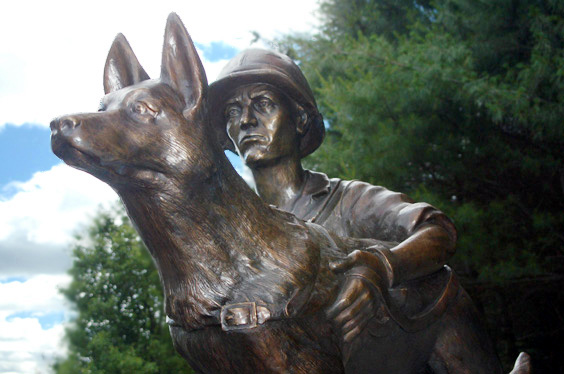
WAR� DOG� MEMORIAL
There were problems right from the start with the
program, first there was no veterinary support in the entire country.
Secondly, the sentry dogs' basic diet was ignored by ARVN officers, because
it cost more to feed the dogs than it did a ARVN soldier. (Note: nearly
90 percent of ARVN dog deaths would be attributed to malnutrition).
Vietnam, 1962. The US Army sent a small detachment of six men, to establish Veterinary Support for the new ARVNs dog program.
Vietnam, 1962. April, for tactical training the U.S. Army sent four K-9 instructors, who started to train ARVN soldiers at Go Vap while a training facility was being built at Thanh Tuy Ha.
Vietnam, 1965. July, the USAF launched Project Top Dog 145. Forty handlers and dogs were deployed to South Vietnam for a period of four months. The teams went to Tan Son Nhut and Bien Hoa air bases near Saigon and to the Da Nang air base, near the demilitarized zone.
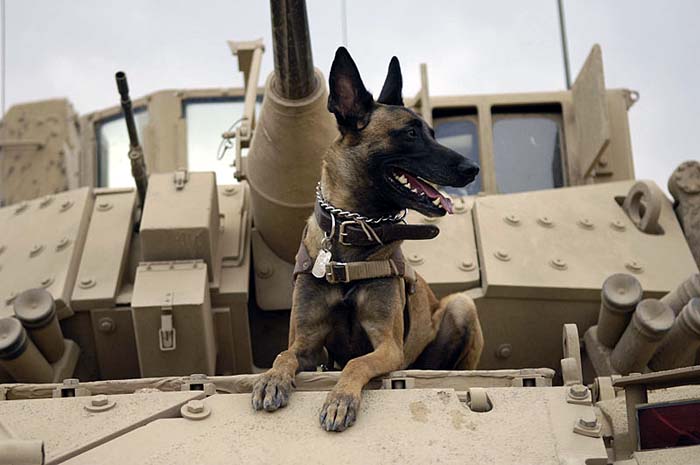
WAR DOG on TOP OF TANK - Wikipedia
Vietnam, 1965. September, following closely on the heels of the USAF, the army began deploying its sentry dogs to South Vietnam. It would reach a war time high of approx. 300 dogs in January, 1970.
Vietnam, 1965. The Scout Dog returns!!! Both the U.S. Army and the Marines initiated scout/patrol dog programs, for use in Vietnam. It was generally acknowledged, that sentry dogs had a limited use and there was a real need for a dog that could be worked around friendly troops.
Vietnam, 1966. February, two Marine scout dog platoons are deployed to Vietnam. This was the first time since WWII, that the Marines would use scout dogs again!
Vietnam, 1966, April, the US Navy and Marines each had one sentry dog unit stationed at Da Nang.Vietnam, 1966. The first opportunity to employ US Army scout dogs in Vietnam came in June, as the 25th IPSD arrived at Tan Son Nhut
.Stateside, 1966. With the end of Project Top Dog, the next AF program was Project Limelight, which purchased more dogs at Lackland, TX; and began the escalation of more dogs shipped to Vietnam; others came from the Pacific Air Force Sentry Dog Center at Showa, Japan.
Vietnam, 1966. Tan Son Nhut Air Base on December 4, one air force handler and three sentry dogs were killed during a VC penetration. This would be the largest battle involving sentry dogs, their handlers and the Vietcong during the entire United States involvement. At home, America was split into two nations; the government decided it was time to pull out of Vietnam and started a phase pull out of ground troops (1969).
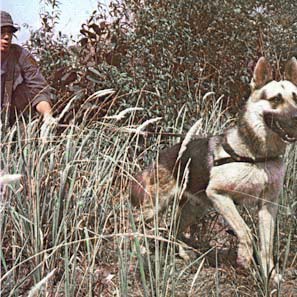
VIETNAM� WAR� DOG - Archives
The peace talks remained stalled until December 1972, when
President Nixon ordered the largest mass bombing of North Vietnam forcing
the North Vietnamese back to the Paris table.
One month later, the Paris Accords were signed on January 27th, 1973.
Thailand, 1969. July: VC sappers attacked Ubon RTAFB; and again in January 1970. During the attacks two handlers were wounded, one dog was killed in action and another two dogs were wounded. Thailand was considered safe duty!
Vietnam, 1970. US drawdown starts! 200 American war dogs are turned over to ARVN, who already had more dogs than it could use or handle or wanted. Never-the-less more US dogs were turned over to the ARVN who now had a canine force in excess of seven hundred dogs
Vietnam, 1970. As the Vietnam War neared the end, the idea of going home was greatly welcomed by the troops, but some of the dog handlers were worried what would happen to their dogs, and a number of handlers tried to get permission to take their dogs home with them, but the military said, 'it was afraid that the dogs would carry disease,' and said no.
When this group of dog handlers appealed for support from the American public, Congress (and the American press), the DoD seemed to have a change of heart, and several hundred dogs were placed in quarantine at Long Binh as a first step towards being sent home to the US.
�Washington DC 1970. Sept 22nd, responding
to stories in the press of the US dogs being left behind in Vietnam, Rep.
John E. Moss (D, California) filed a bill (HR-19421), that would had established
retraining or retirement in humane shelters for canine veterans. The bill
died in committee. 1970 - 3,000 est. dog casualties? About 1,000
dogs serving?
Fact or fiction...your guess is as good as mine, there was, and unfortunately
still today, so much misinformation being quoted about the dogs of Vietnam,
that we'll probably never know the real truth or actual figures.
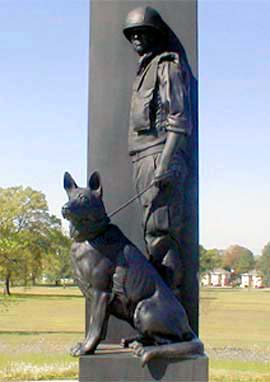
WAR� DOG� MONUMENT,� FT. BENNING, GA
Vietnam, 1970. Just about then, the government reversed its position feeling that the risks were too great. The dog handlers were now told that the World Health Organization had passed a ruling saying that no animals were to come out of Vietnam. Years later, the World Health Organization denied it ever said any such thing.
For what ever the reasons were, the military decided, that the dogs who served in Vietnam were not be repatriated.
At the time, the choice was justified by the military as being practical, but perhaps the bitter truth was, that the dogs were unwanted stateside because they were surplus, and turning them over to ARVN was cost effective and solved what could have been a huge logistical problem for the US military, who was now preparing to downsize to a peace time army.
ARVN didn't want them and neither did we at the time!
Vietnam, 1971. May 3rd, 2 C-5A transports arrived at Long Binh, to pick up 120 dog returnees, (all that remained of the original 200, who were quarantine), of this number, 15 scout dogs were left in Okinawa and the rest (105) made it back to the United States to Lackland AB and Fort Benning.
The only other dogs that made it back to the USA were a 'war hero,' Nemo who returned earlier, and Turk. Turk was brought back to help a former handler, who lay near death in a coma. The handler died while Turk was on route and the dog was returned to Vietnam, after several days at Fort Benning.
Vietnam, 1971. June, the Marines, who were the first in Nam with scout dogs, withdrew their remaining scout dog platoons from the theatre of operation.
Stateside, 1971. With the start of the phased withdrawal of all American troops from Vietnam, the US began to dismantle its MWD programs at home. The army dog training school at Fort Gordon was closed.
Vietnam, 1972. By June only about 130 dogs remained under the control of the United States; they were turned over to the ARVN, thus ending the final chapter of the American MWD in South Vietnam! Victory for the VC and North Vietnamese was now assured; and eventually, both the South Vietnamese civilians and military streamed into Tan Son Nhut Air Base and Saigon hoping to escape the brutality of the advancing Communist forces.
Vietnam, 1973. March 29th, between 11:30 and 1300, the last remaining security police of the last operational squadron in the Republic of Vietnam, the 377th Security Police Squadron, were withdrawn from Tan Son Nhut Air Base. The last man to leave was the commander, Lt. Colonel Bill Luckett.
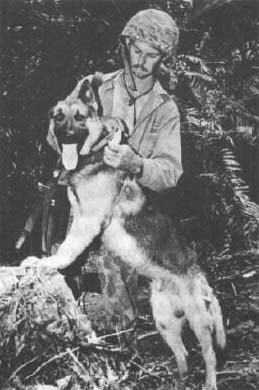
WAR DOG and HANDLER
It is now believed that vitually all of the "remaining" war dogs that were "turned over" to ARVN perished then; unfortunately there're no "official records" available of the exact number of American War Dogs that were still in ARVN possession at the time.
�During the Vietnam War 1960-'75, about 4,000 American war dogs were employed in various capacities, of these a few died early on in the war from food contamination; the Vietnam sub tropical climate killed several hundred more...according to the Army Veterinary Corps, 109 war dogs died from heatstroke in 1969 alone; and from June 1970 thru to December 1972, 371 dogs were euthanized as being non-effective in combat, and a other 148 died from various causes; during the entire war 281 were officially listed as killed in action...or was it more?
More than 9,000 Army, Navy, Marine, and Air Force handlers served in Vietnam during America's involvement.
Were the dogs of Vietnam effective? Our military experts
and "armchair Generals" will probably be debating that
question for the next hundred years. But any Vietnam combat veteran,
that happened to be part of a patrol, that was saved from an VC ambush
because of a scout dog's alert or prevented from walking into a mine field...will
tell you, the answer is definitely yes!
The Viet Cong thought so too.....they placed bounties on both, the American
handlers and their war dogs!
Estimates vary, but some state that the dogs may have been responsible
for the saving of at least 10,000 lives in Vietnam.
In the last two years, there has been four War Dog Memorials dedicated to the Dogs Of� Vietnam: Today the members of the Vietnam Dog Handlers Association continue to sponsor a drive to establish the first National War Dog Memorial, to honor all War Dogs, who Served the United States of America in Combat.
These War Dogs gave everything they had for their country, only to be ?unwanted? and left behind to perish.
Ctsy HAHN?S 50th AP K-9, WEST GERMANY.